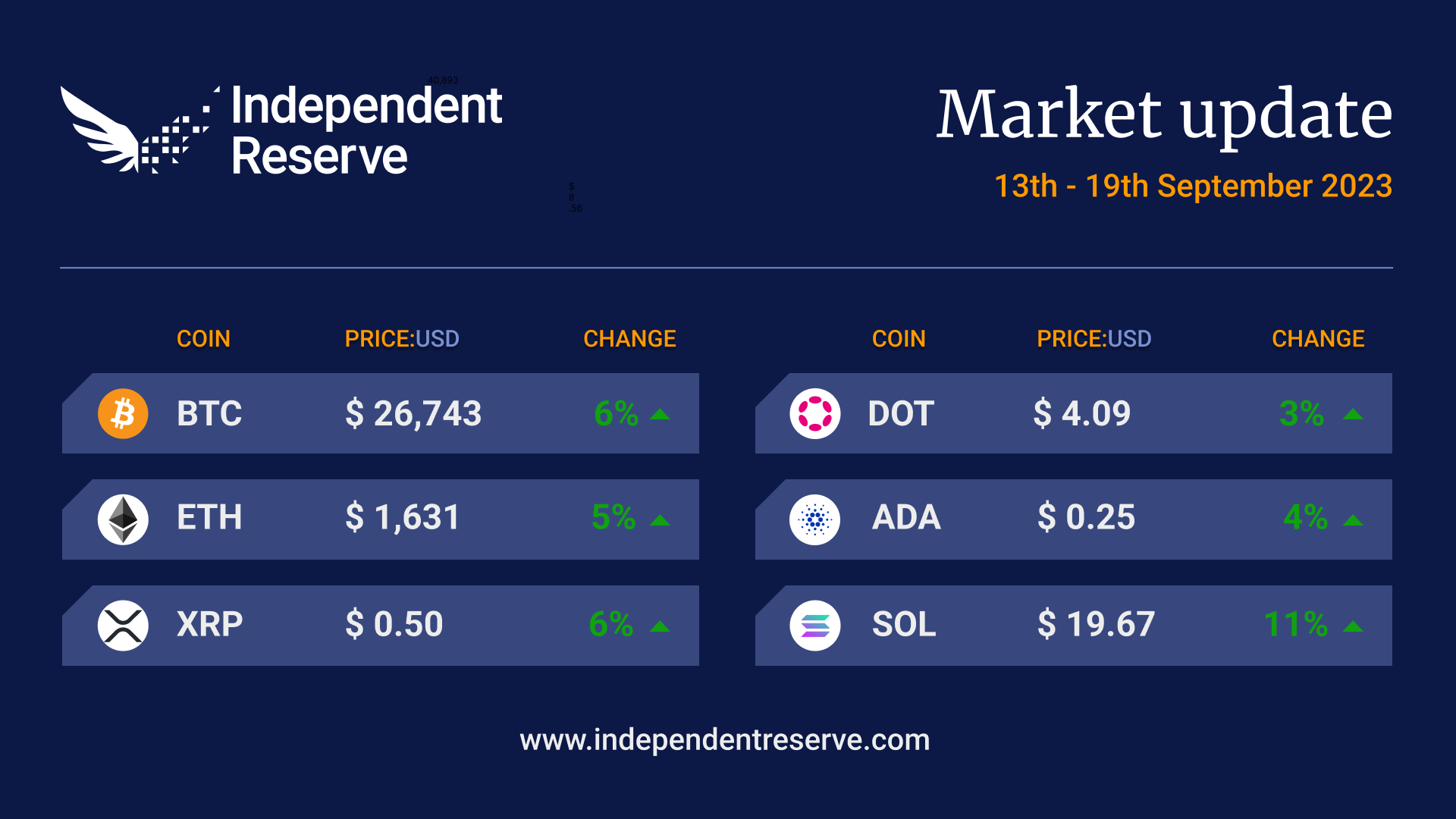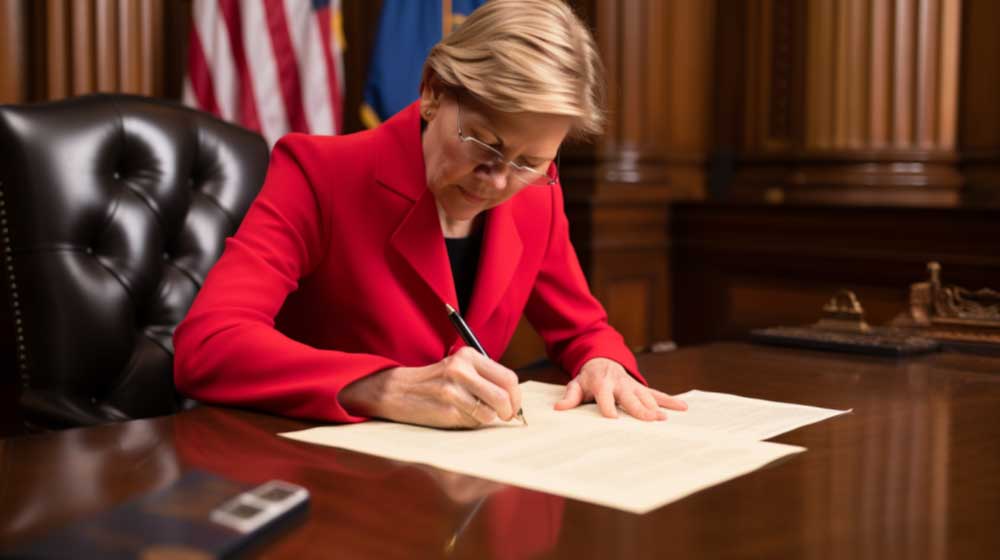In markets
After a sharp drop to A$38,890 (US$25K) this time last week, Bitcoin on our Bitcoin exchange has recovered 6% to trade around A$41,580 (US$26,740), and Ethereum is up 5% to trade at A$2,530 (US$1,630). It was a sea of green elsewhere, with gains for XRP (6%), Cardano (4%), Dogecoin (2%) and Polkadot (2%). Telegram messaging app TON surged 48% and is now in the top 10 coins according to Coinmarketcap after the app integrated TON’s self-custodial crypto wallet for its 800 million users. The Fear and Greed Index improved to 46, which is still Fear.

From the OTC desk
This week’s cryptocurrency price action has been positive – right throughout the complex. The majors, stables and alts have generally moved together, highlighting a positive turn in risk sentiment. Historically, cryptocurrency sentiment has been correlated with moves in fixed-income yields, as well as US technology equities. For the time being, however, the price movement in cryptocurrencies is generally unrelated to traditional markets. Put another way, there has been a very limited correlation between the major cryptocurrencies to traditional assets over the past 30 days – and this includes commodities!
Despite this breakdown, it is expected that this week’s US Federal Open Market Committee (FOMC) meeting will be critical for confidence and capital allocation into alternative assets – like cryptocurrencies. The ‘market’ seeks confirmation that maximum interest rates have been reached. Thursday 4:00am AEST, the FOMC will announce their interest rate decision for September. This will be followed by a press conference, where Chair Jerome Powell will provide commentary and forward guidance on behalf of the Committee. Watch this space.
In China, ongoing (piecemeal) stimulus continues to be deployed by the People’s Bank of China (PBoC). So far the PBoC has undertaken broad measures of stimulus (including reducing the prime lending rates, as well as reducing direct property acquisition costs, like stamp duty) to stabilise the domestic property segment. Stimulatory lending policy, as well as stronger-than-expected August retail sales and industrial production, have boosted global asset market confidence. In general, China’s stimulus will most likely be taken as a positive for risk assets.
This week’s China economic data includes the September announcement of the 1yr and 5yr prime loan rates (Wednesday at 11:15am AEST). Currently, the market is forecasting for these lending rates to remain unchanged at 3.45% and 4.2%, respectively. Expect the foreign exchange markets – and in particular AUD/USD – to watch this data release carefully.
On the OTC desk, the positive cryptocurrency sentiment has resulted in broad-based buying. Interestingly, much of this week’s inquiry has centred around altcoins – with a particular interest in tokens associated with stablecoin projects. Broadly speaking, stablecoins have been the dominant and consistent theme of the year, with OTC trading volumes in both USDT and USDC consistently increasing. For the past few months, sell-side flow (or stable coin offramping) back to USD and AUD has been dominant. This week, trading flow in stables has been much more balanced. Trading flow has seen the USDT move back above 1:1 USD. This change in activity appears to highlight a genuine interest in risk sentiment and altcoins.
For any further information, please feel free to reach out.
In headlines
Token2049 in Singapore
The biggest crypto conference of the year — at least in this hemisphere — Token2049 took over the Marina Bay Sands in Singapore this week. The overall vibe was “What bear market?” and there is an expectation markets will turn around next year. Frequent themes included the upcoming Bitcoin halving, AI and crypto, the contrast between the US crackdown on crypto with growing regulatory certainty in Asia, plus the emergence of cross-chain protocols and messaging systems.
ANZ and Chainlink
ANZ has completed a transaction using its A$DC stablecoin and Chainlink’s Cross Chain Interoperability Protocol (CCIP) — a universal messaging interface that communicates between blockchains using LINK’s Oracle network. The test demonstrated the system’s ability to transfer funds across both open and private blockchain networks.
Citibank’s cross-border transfers
Citibank will use digital tokens for cross-border transfers, but it won’t be using XRP. Instead, Citi Token services will use its own private permissioned blockchain to “integrate tokenized deposits and smart contracts into Citi’s global network” for payments, liquidity and automated trade finance solutions for institutional clients.

The bearish view
Investment manager VanEck reports that decentralised exchange volume declined by 15.5% in August while TVL declined 8% down to US$37.5 billion (A$58.2B). Meanwhile, CoinShares chief strategy officer (CSO) Meltem Demirors reported seeing “last week, 70% less trading volume in publicly listed crypto products, and we’re also down 30% in trading volume on the spot and derivatives side.” She told Bloomberg the apathy and uncertainty were putting off investors. “There’s just a lot of uncertainty, and right now what we’re seeing is that summer of apathy has the potential to turn into a winter discontent as we continue to see investors, traders, market makers, sitting on the sidelines.”
New plan to make Gemini Earn customers whole
Conglomerate Digital Currency Group, its crypto lender Genesis Global and the Winklevoss twins owned Gemini exchange have been at loggerheads since FTX collapsed and Genesis halted withdrawals leaving 230,000 Gemini Earn customers with hundreds of millions frozen. DCG has now proposed an agreement with Genesis that would see Gemini Earn customers recover 70-90% of their funds and is calling on Gemini to stump up the remaining US$100 million (A$155M). Gemini’s lawyers aren’t impressed, calling the proposal “misleading at best” and suggesting DCG and Genesis are short-changing it. Gemini Earn customers will get to vote on the proposal.
FTX market dump
The Delaware Bankruptcy Court has approved the sale of FTX’s US$3.4B (A$5.3B) of digital assets. It will be limited to selling US$100M (A$155M) per week but may be able to increase the amount further up to US$200M (A$310M) each week. Messari argues FTX’s Bitcoin and Ether holdings are a tiny fraction of the coin’s weekly trading volumes, so it shouldn’t have a huge impact. And most of FTX’s Solana is locked up, so just US$9.2M (A$14.3M) will be unlocked and able to be sold each month.
SEC goes after NFTs
The SEC has forced the creators of the animated web series Stoner Cats to cough up a US$1 million (A$1.55M) furball for selling NFTs it believes are securities. The Mila Kunis-backed show raised US$8 million (A$12.42M) through the sale of 10,000 NFTs, which the SEC believes led “investors to expect profits because a successful web series could cause the resale value … to rise.” SEC Commissioners Mark T. Uyeda and Hester M. Peirce dissented and pointed out that if Stoner Cats are illegal, then so was selling “Star Wars collectibles…in the 1970s.” The floor price of Stoner Cats NFTs surged 250% on the news.
MAS bans founders of Three Arrows Capital
Singapore’s Monetary Authority of Singapore (MAS) issued prohibition orders lasting 9 years against Zhu Su and Kyle Davies, the founders of Three Arrows Capital. They are now banned from participating in the management, acting as directors, or becoming substantial shareholders of any capital market services company regulated in Singapore. The orders were issued because Three Arrows Capital failed to implement adequate risk management frameworks for cryptocurrency and digital assets, with Zhu and Davies found primarily responsible. The regulator also noted that the company provided false employment information. MAS Assistant Managing Director for Policy, Payments and Financial Crime, Ms. Loo Siew Yee, stated that the authority would act to remove senior managers who engage in such misconduct.
Hong Kong regulators take aim against JPEX
The Hong Kong Securities and Futures Commission (SFC) issued a warning last week against using the cryptocurrency exchange JPEX, accusing it of “suspicious features” and promoting misleading information about its licensing. “No entity in the JPEX group is licensed by the SFC or has applied to the SFC for a license to operate a VATP in Hong Kong,” it said. Following last week’s announcement, the Hong Kong police arrested six people concerning suspected cryptocurrency fraud.
Binance.US case looks bad
Binance.US is looking shaky, and the claim by international parent company Binance Holdings that it has nothing to do with Binance.US is looking increasingly dubious. In court, the SEC has complained that Binance is not cooperating with document production that would prove whether Binance Holdings is in control of Binance.US funds and argues that Ceffu — formerly Binance Custody — is controlled by it. It also alleges that Binance.US’s own auditor said it was “difficult to ensure the company was fully collateralized at all times”. Binance.US has lost half a dozen executives, including its CEO, and has culled one-third of its staff. Former SEC and New York Fed regulator Norman Reed has now been appointed CEO.
Crypto bills in US
Anti-crypto Senator Elizabeth Warren has now signed up 12 senators for her bipartisan bill to crack down on the crypto industry. The New York State Department of Financial Services has called for feedback on “enhanced criteria for coin listing and delisting procedures”, and the Chairman of the House Financial Services Committee, Patrick McHenry, is pressing ahead with bills to ban the US from issuing a CBDC.

Metamask Snaps
Metamask has finally launched 34 Snaps, third-party plugins providing additional functionality. There are Snaps expanding the wallet to Cosmos, Solana, Tezos, Starknet and Algorand, as well as security plugins that will simulate transactions so you don’t get ripped off. THORChain surged 29% this week after its cross-chain swaps were made available via the ShapeShift Snap.
The Merge at 1
It’s been one year since the Merge when Ethereum switched on Proof Of Stake. A Merge price surge did not occur, although ETH is up 10% on one year ago. Anthony Sassono noted that since the Merge, 980,000 ETH has been burned, 11.6 million ETH staked, and 362,000 new validators have joined the network. The devs this week rolled out a new testnet called Holesky that’s twice as big and which will replace the Goerli testnet. And on September 13, Ethereum saw its second-highest-ever count of daily active addresses. “This historic anomaly could be the capitulation signal needed for prices to rebound,” Santiment said.
Until next week, Happy Trading!


